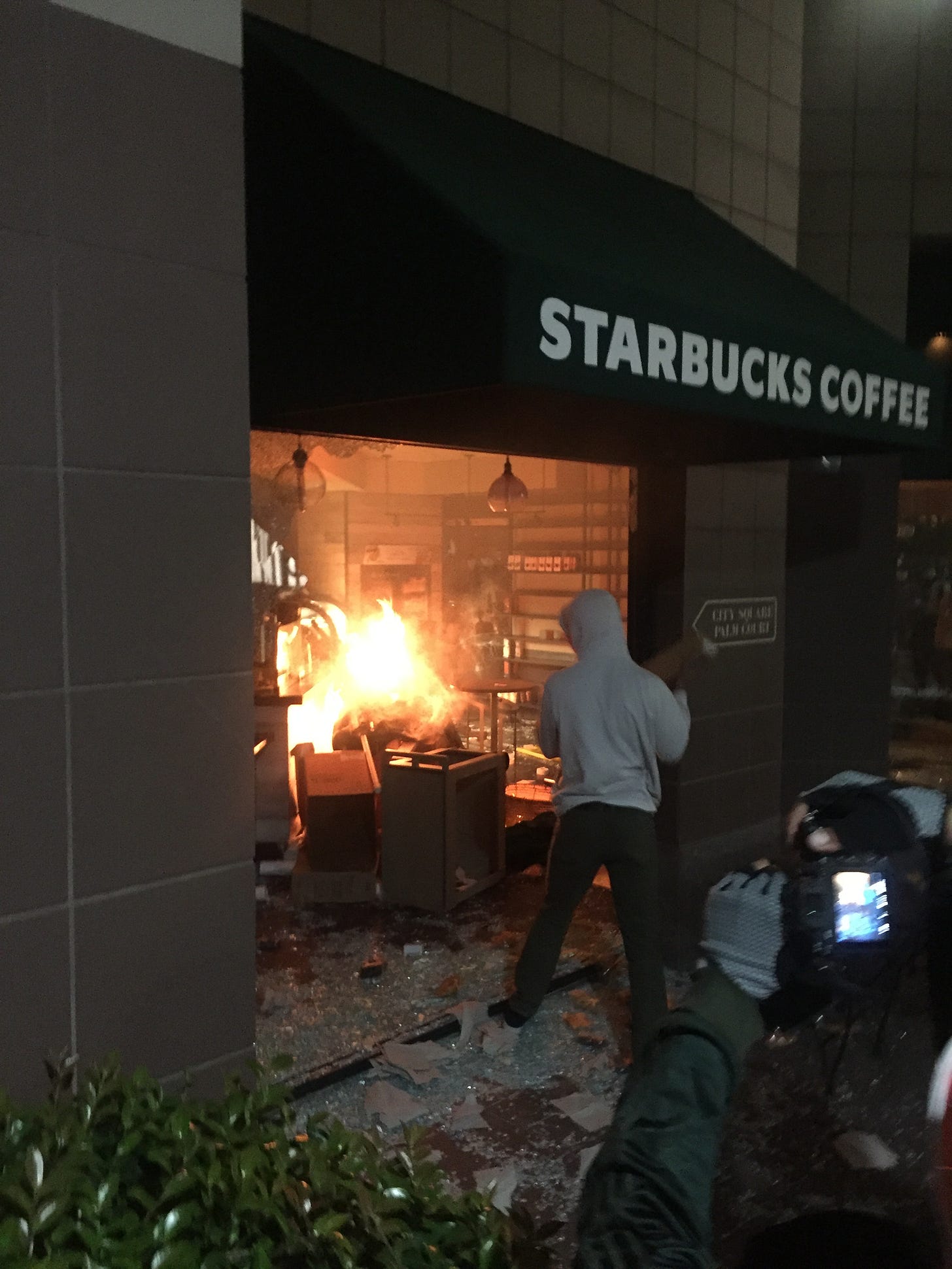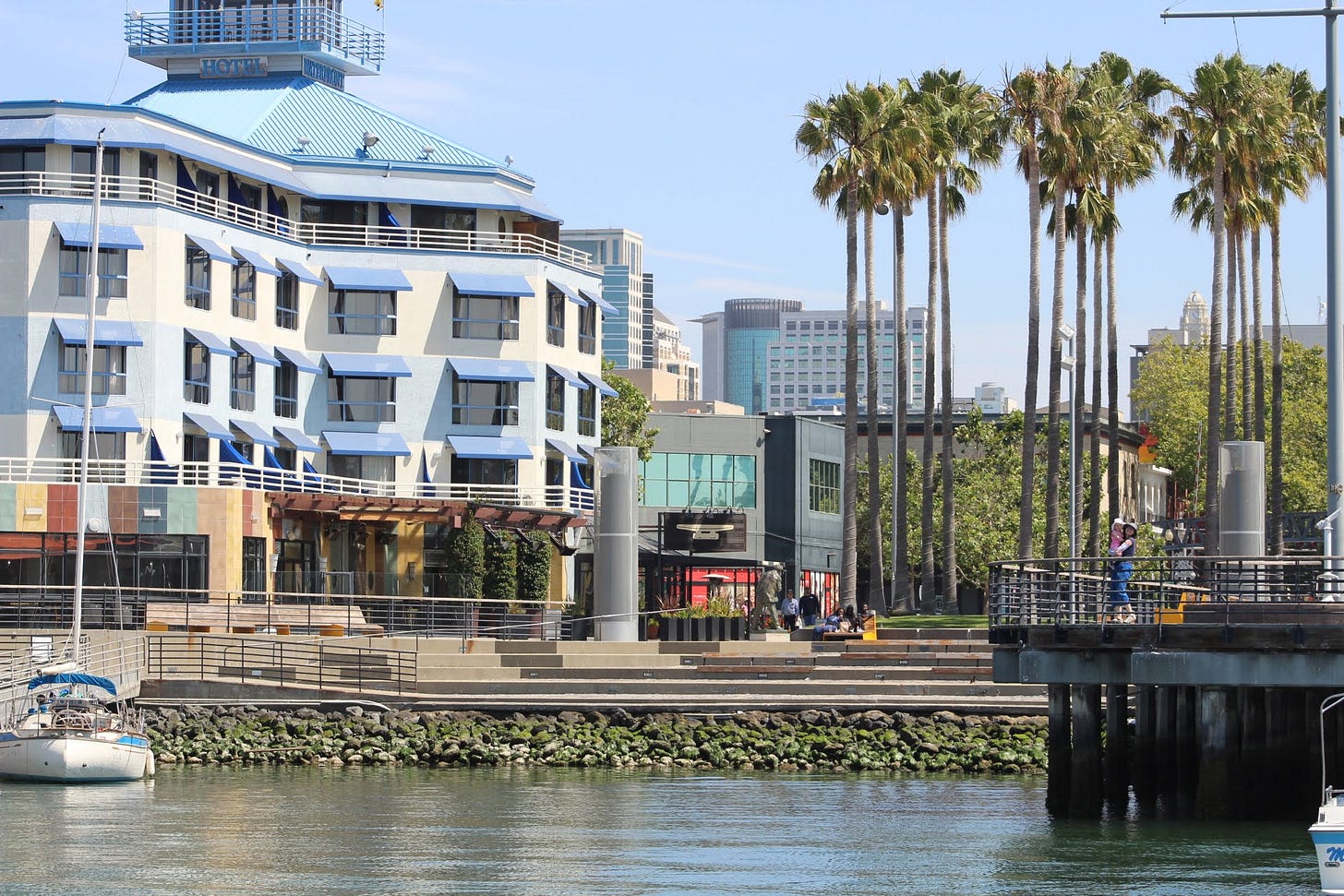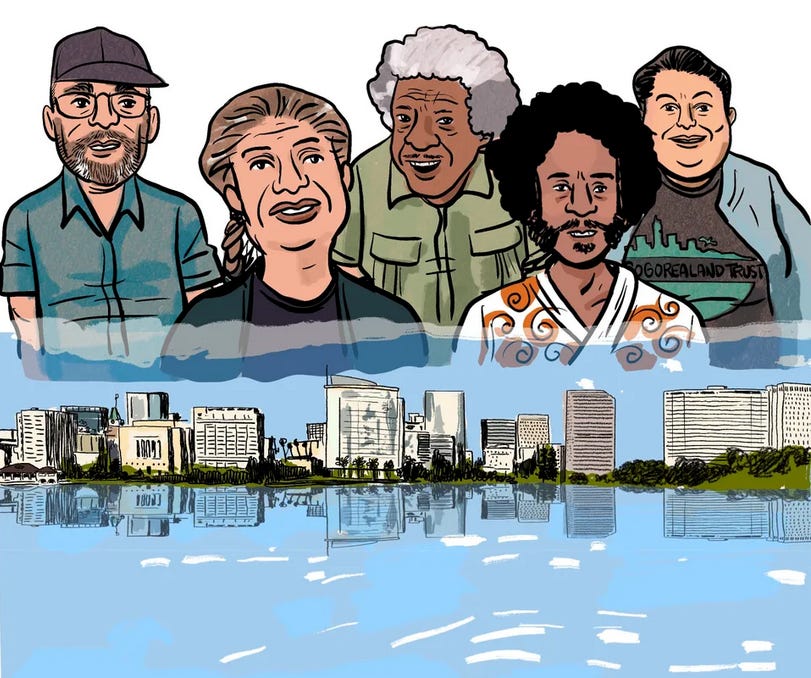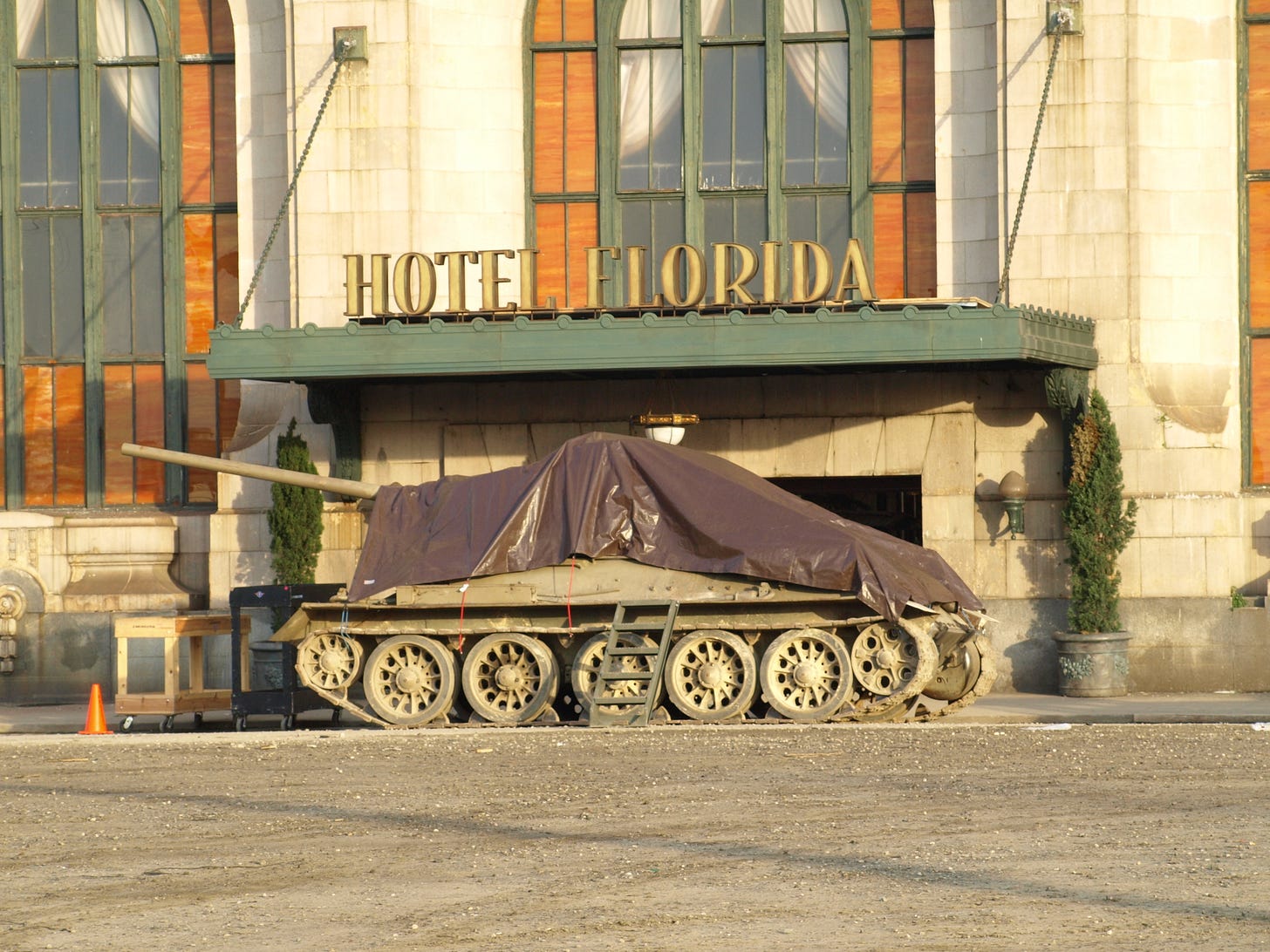Earlier this year, a group of my neighbors started organizing a monthly clean-up of our block. For a few hours every second Sunday, folks join forces to prune trees, remove litter, and generally spruce things up. It’s been a great way to get to know each other better, but one of the other goals is improving public safety. On an email thread, one of my neighbors reported approvingly that she’s noticed more people walking on our street since the cleanups started.
I was thinking about the relationship between foot traffic and public safety the other day when I was on a walk through a residential section of Clinton, a relatively quiet neighborhood east of Lake Merritt. While admiring a scallop-shingled witches’ hat tower protruding from one of the neighborhood’s many Victorian homes, I noticed a small group congregating down the block. Walking closer, I saw that this mixed group of dog owners, families, and young couples was congregating in front of a cafe, the only commercial business in the vicinity. On my hour-long walk, this was by far the most people I’d seen.
I’d never been to this cafe before, but a little research revealed that it hosts gatherings for community groups and pop-up vendors, exhibits local artists, and provides space for low-key musical performances. In an area where most of peoples’ lives are lived behind closed doors, this cafe seems to provide an ideal “third space” for people to come together. Besides supplying the local population with a reliable source of caffeine, this is one of the most important roles of a cafe – it’s also why they can be so controversial.
I’ll never forget the first time I attended a Berkeley City Council meeting about 20 years ago, when I was an intern with the San Francisco Bay Guardian. During a discussion about a proposed Starbucks, an elderly woman with wild purple hair stood up on a chair to loudly denounce the corporate coffee chain. I don’t remember her exact words, but I do remember most of the audience clapping and hooting in ferocious approval of her stance. During the late 1990s and early aughts, if a political protest turned violent (i.e. “The Battle of Seattle”), the windows of Starbucks were always among the first to be bricked.

Long before more recent controversies involving racial bias and union busting, Starbucks was vilified by some as the ultimate symbol of gentrification and homogenization of culture. People really cared about their locally-owned cafes (picture mismatched furniture and flier-covered bulletin boards) and saw the looming green mermaid logo as a threat to these unique spaces. I’m sure that Starbucks indeed drove some mom-and-pops out of business, but in Oakland, at least, it appears that there’s plenty of room for corporate cafes as well as more flavorful shops.
Currently, there are thirteen Starbucks locations in Oakland and yet, defying the doom loop trend, independent cafes are still sprouting all over the place. Within the past few years, several Yemeni and boba-oriented shops have opened to serve growing Middle Eastern and Asian populations, while specialty shops serving rotating menus of flavored coffee drinks to office workers and residents of the new, upscale residential towers have popped up downtown. Yes, some beloved local cafes, like Rooz, have shut down, but that was reportedly due to crime, not competition.
My point here isn’t to defend Starbucks (personally I don’t like their coffee and would always prefer to support a locally-owned biz), but to observe how, more than almost any other kind of business, cafes are a prominent reflection of our ever-changing tastes, values, and culture. A new cafe can signal the shifting demographics of a neighborhood, it can cultivate an arts and music scene by giving beginners a place to show off their talents, or, according this Economist article, it can even serve as an unofficial incubator for other small businesses. It can also serve as the de facto gathering space in residential areas, boosting foot traffic on otherwise quiet blocks, like the cafe I noticed in Clinton last week.
All of these are reasons why the cafe is such an essential element of the urban fabric and why, aside from gentrification concerns, most people are happy to see one arrive in their neighborhood. For my latest SF Gate article, I interviewed an Oakland resident who is frustrated that “a robot-operated corner store” is opening up in one of the Golden Gate area’s vacant retail spaces. He told me that he’d consulted with many of his neighbors and that the consensus was that people would much rather see a coffee shop. “Now you have to walk, like, 12 minutes in either direction to get to a coffee place, and in a vibrant area, there should be one closer than that,” he explained. In other words, a lively city can never have too many cafes!
More East Bay Yesterday News
If you appreciated the essay above and want to hear about Bay Area coffee history, check out the latest episode of the East Bay Yesterday podcast. The main story is about how Alfred Peet launched an American coffee revolution from his pioneering Berkeley cafe in 1966, but the episode also gets into beatniks, the birth of 3rd wave, and much more. Available wherever you listen to podcasts.
Final boat tours of 2024: I’m doing my last Oakland/Alameda history boat tour on September 6 (the new route!) and my final Richmond/Albany tours on October 19 and 20. Click here for tickets. [Got questions about the tours? Check out this FAQ page.]
My friend Chris Carlsson of Shaping SF also has a few upcoming boat tours focused on San Francisco history. You can get tickets to his tours here. Also, if you missed my presentation on the history of KPFA, I’ll be doing it again on October 16 as part of Shaping SF’s fall Public Talks series. The event doesn’t have a web page yet, but all the details should be on Shaping SF’s site shortly. On a sidenote, Chris responded to my recent coffee episode by sharing this article about San Francisco’s history as a major hub of coffee importation. You’ll never look at the Hill Bros. building along the Embarcadero the same after reading this horrifying account of colonization.
On October 28, come to Clio’s to see me in conversation with Rosanna Xia, the award-winning author of “California Against the Sea: Visions for Our Vanishing Coastline.” We’ll be exploring “what sea level rise means for the Bay Area” through a historical lens, with a specific focus on threats faced by the East Bay’s flatlands neighborhoods. It won’t all be doom and gloom though, because we’ll also be discussing some promising mitigation efforts, like wetlands restoration at the old Alameda Naval Air Station. Get tickets here.

Thanks to KQED for including me in an article about how Kamala Harris’ campaign is sparking (even more) right-wing criticism of the Bay Area, as I predicted in last month’s newsletter. One thing I couldn’t have predicted is how laughable most of these attacks have been so far. Case in point: During a “speech” last week, Donald Trump said “San Francisco was a great city 15 years ago.” As many have pointed out, 15 years ago, during this apparent golden era, Harris was the city’s district attorney and Trump’s other nemesis, Gavin Newsom, was mayor. Oops.
Update on “Reflections on Lake Merritt” documentary: Big shoutout to everyone who came to our sold out fundraiser at Cameron-Stanford earlier this summer! Not only did we raise a few thousand for the film, but local artist Frederick Noland published an illustrated review of the event [see image below]. We’re doing a few more interviews this month, but after we wrap these up, we’ll be shifting gears into editing and hopefully incorporating some animation into the film (since no video footage exists of Oakland in the 1800s). If anybody reading this has suggestions for distribution, please drop me a line, and if you want to contribute, the Go Fund Me campaign is still running. Oh, and if you want to see more of Fred Noland’s work, he also recently published a great cartoon about visiting Mountain View Cemetery.
In Other News
There are many interesting tidbits in this longread about Deward Hastings, better known as Berkeley’s (in)famous “Hot Tub Guy,” including much speculation about what motivated him to open his backyard to strangers for nearly five decades. One of the prominent theories is that Hastings, who dropped out of Cal in the early 1960s after studying chemistry for two years, earned a fortune on the black market by making quaaludes and wanted to give back to the community to atone for the damage inflicted by this sketchy drug. Did you know that the name quaalude is a portmanteau of “quiet interlude” – neither did I! Read the entire, engrossing saga at Alta Magazine.
“Billionaire Gordon Getty’s Greco-Roman villa for sale in Berkeley Hills” and it can be yours for $5 million. The “Temple of Wings” was originally designed by Bernard Maybeck in 1911 for Florence Boyton, a modern dance teacher. Since Boyton taught in the style of Isadora Duncan, who danced wearing Greek robes, Boyton wanted to live in a Greek temple (obviously!). The home was initially constructed without walls, meaning that the family was basically sleeping outside. Must’ve been chilly. The property was dramatically reconfigured after a 1923 fire and you can see photos of what it looks like currently in this SF Chronicle article.
Most Oakland Heritage Alliance walking tours traverse the streets of The Town, but one recent experience brought attendees behind the scenes at the Posey Tube. “When the tunnel was built just under 100 years ago, it was an engineering phenomenon and an early Art Deco marvel,” according to Oaklandside’s Natalie Orenstein. Despite the tunnel’s impressive design, I’m still excited that taking a free ferry between Oakland to Alameda is now an option, instead of being forced to ride through the tube’s notoriously narrow bike lane.
The New York Times’ lengthy obituary for Lewis Lapham omitted one important chapter of the legendary journalist’s life: His early years as cub reporter for the Oakland Tribune in the 1950s. A few years ago, Mr. Lapham was the keynote speaker at the Oakland Book Festival, where he regaled the crowd with lurid tales of municipal corruption, police misconduct, and rampant alcohol abuse by his more grizzled colleagues. I reached out to Clio’s owner Timothy Don, who co-organized the Book Fest to see if Lapham’s speech was recorded, but sadly it wasn’t. My memory of the specifics are hazy, but if I remember correctly, one of his stories involved police officers sharing confiscated pornographic film reels with crime reporters in exchange for favorable coverage. I’m kicking myself for not interviewing Lapham about this – I would have loved to hear him flesh out the details (pun most definitely intended).
In honor of Honor Kitchen’s grand re-opening, the Emeryville Historical Society dug into the extremely eclectic history of the restaurant’s Powell Street location. Things kicked off a century ago, when the building was raided in 1924 for hosting “illegal Chinese gambling operations.” Although rumors that it served as a bordello can’t be verified, the site has housed a German hofbrau called Bavarian Village, a Chinese restaurant that featured live reggae, a punk/metal club that hosted acts such as White Trash Debutantes, and a Korean-owned sushi restaurant.
Richmondside is the latest news site in Cityside’s growing mini-empire. Similar to Berkeleyside and Oaklandside, the outlet will profile notable locals. One of the first Richmonders to be featured is Jack London’s great-granddaughter (and veteran enviro justice activist) Tarnel Abbott. Longtime East Bay Yesterday listeners may recall that Abbott was also featured in one of my first episodes, about London’s “The Iron Heel,” which is widely considered to be the first dystopian novel, and an inspiration for later works including “1984.”
“One thing about living somewhere for a long time is that you can see places change.” So begins another post on Andrew Alden’s long-running Oakland Geology blog. This post traces the changes he’s witnessed at Dracena Park, a former quarry, over the past 16 years and offers some proposals on how the crumbling landmark could be improved.
I’m not going to pretend that the level of crime in Oakland is acceptable or that our city leaders are doing a good job at improving public safety, but putting current crime stats in historical context is important. In his latest newsletter, journalist Ali Winston points out that the number of robberies last year was far lower than ten years prior (“2013 - Over 4,800 robberies in Oakland; 2023 - Over 3,600 robberies”). The big difference is that 10 years ago, we weren’t seeing nearly as many brutal videos of stickups and purse-snatchings constantly circulating on Instagram and Twitter. Another factor is that good news usually doesn’t make the news. I was speaking with a former Black Panther the other day who pointed out that TV news vans don’t show up to most community gatherings and festivals unless violence occurs.
Berkeley Historical Society will be screening the premiere of “Inside the Free Speech Movement,” a new documentary about the influential 1964 student uprising, on September 5.
Sponsored Message
UCSF Benioff Children's Hospitals are committed to supporting the health and development of all children. In 2016, amidst a surge of anti-immigration rhetoric and policies, a group of Oakland UCSF providers became deeply concerned about the health and wellbeing of their immigrant patients. They started the UCSF’s Center of Excellence for Immigrant Child Health and Wellbeing, an initiative that addresses the health of immigrant children through advocacy, education, and evidence-based clinical services. Today this volunteer-run pediatric health center provides care that makes a critical difference. To learn more about the Center, check out this article.
Finally
This scene below doesn’t look like West Oakland, but it is! In 2011, the HBO movie "Hemingway & Gellhorn" transformed the 16th Street Station into the Hotel Florida, the place in Madrid where Ernest Hemigway was based during the Spanish Civil War. The derelict train station, built in 1912, was the perfect set for this 1930s period drama. This photo was sent to me by Rick Faszholz, who heard my recent podcast about the station and remembered that he took this photo more than a decade ago. Don’t forget: If you want to see this historic building saved, sign the petition.
Thanks for reading all the way to the end. Extra special thanks to those of you supporting East Bay Yesterday through Patreon or through a paid subscription to this Substack. The only reason that I’m able to devote so much time to this project is because of your generosity.
-Liam
PS: I’m finally going to do an episode about one of the last major locations on the Long Lost Oakland map that I haven’t covered yet. Expect it to drop mid-September. Here’s a hint…








based on context clues, I'm assuming you wandered by Xochi the Dog cafe! I cannot sing that place's praises enough. Also, long time listener, first time commenter. Thanks for doing what you do!
No mention of Peets?
I read that Alfred Peet explained the coffee biz to the bros who started Starbucks with the understanding that Starbucks would never compete head-to-head with Peets.
Is this folklore or yet another reason to shun Charbucks"?